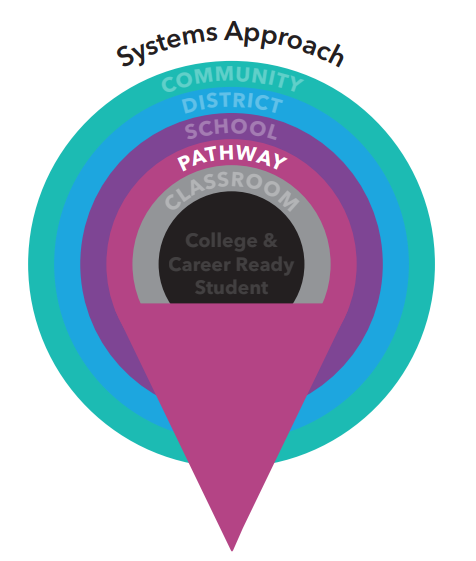 Role of the Pathway
Role of the Pathway
The role of the pathway in the system is to maintain the integrity of the program of study. This is done by designing it in a way that both aligns the student learning outcomes with the graduate profile and creates a learning experience that incorporates the four core elements: rigorous academics, career technical education, work-based learning, and student support. The program of study provides performance-based learning and assessment experiences that transform what students are able to know and do upon graduation and positions students to have a college and career readiness plan in place that they are able to undertake. Lastly, pathways must also create the infrastructure, processes, and learning spaces needed for teachers to collaboratively review data, develop curriculum, refine practice, and revisit outcomes to maintain a high-quality program of study with authentic learning opportunities.
Pathway Essential Element Domains and Resources

The progress of every student toward measurable and consequential learning outcomes is the driving purpose for the pathway Community of Practice. The pathway team regularly reviews several kinds of evidence, including: (1) performance-based measures of pathway-specific student learning outcomes; (2) information on students’ level of performance, available from student information systems; (3) individual student growth in performance, both on pathway specific learning outcomes and on transcript-based measures; (4) students’ success after high school in postsecondary education and employment, if available; and (5) trends over time in all these measures for the pathway students as a group. The team uses data on a monthly basis to inform and improve professional practice, and on an annual basis to revise the pathway improvement plan.
Domain Resources 1-4:

A college and career readiness pathway pursues both excellence and equity as mutual goals. A pathway establishes high achievement expectations for all students and practices non-discriminatory and inclusive policies, practices, and pedagogy. The pathway is equitably accessible to and serves well any interested student, regardless of race, ethnicity, gender, sexual orientation, socio-economic status, special needs, or prior academic achievement. An equity-focused pathway intentionally reflects the diversity and strengths of its school, community, and district, and the grouping of its students is heterogeneous, flexible, and equitable.
Domain Resources:

An industry-themed pathway program of study brings coherence to the four core components of college and career readiness rigorous academics, real-world technical skills, work-based learning, and personalized supports. It intentionally coordinates and sequences student learning experiences in a way that integrates rigorous academic and technical core curriculums. The pathway theme is broad enough to appeal to and engage all students. The program of study maximizes cohort scheduling to ensure that all pathway students are offered the opportunity to earn postsecondary credit and are prepared for success in the full range of post-secondary options.
Domain Resources:

Pathway students engage in inquiry and project-based learning that is outcome-focused, rigorous, relevant, and collaborative in nature. Members of the pathway Community of Practice plan these learning experiences for students. They regularly collaborate to develop and articulate standards-aligned grade-level, course, and project outcomes to organize the pathway’s program of study and guide assessment, curricular, and instructional planning. They also use performance assessment tasks with common rubrics to assess, monitor, and support every student’s progress toward mastery of college- and career-ready pathway learning outcomes. The Community of Practice regularly engages in professional learning, evidence-based inquiry, and reflection to continuously improve their practice.
Domain Resources:

All students participate in a personalized and coordinated continuum of work-based-learning (WBL) experiences designed to help them master and demonstrate academic, technical, and 21st Century skills, as identified in the pathway student learning outcomes. WBL builds on and extends every pathway’s program of study. WBL occurs in-person and online: in the workplace, the community, and at school. Students acquire academic, technical, and 21st century knowledge and skills through WBL, which enhances their preparedness for the demands of college and careers.
Domain Resources:

Every pathway student is supported by pathway staff, partners, and families. The pathway Community of Practice tailors learning experiences to students’ individual developmental needs, skills, strengths, interests, and aspirations. Pathway staff, in consultation with families and service providers, identify and address the academic, personal, and social-emotional needs of every student so that s/he makes progress toward personalized college and career goals and pathway student learning outcomes.
Domain Resources:

The pathway staff, school, and district leaders and partners share responsibility for program effectiveness and accountability for student outcomes. These stakeholders assure that conditions are in place to establish and sustain pathway quality. The pathway engages a formal advisory board that serves as an organizing structure to effectively engage a core of stakeholders, including business, post-secondary, and community partners.
Domain Resources:
)